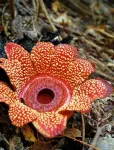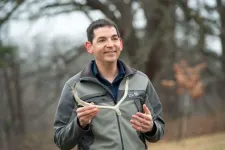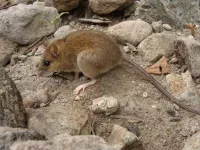(Press-News.org) On January 22 in Current Biology, a team of Harvard-led researchers presented the most complete genome yet assembled of one of the major Rafflesiaceae lineages, Sapria himalayana.
The species is found in Southeast Asia and its mottled red and white flower is about the size of a dinner plate. (It's more famous cousin, Rafflesia arnoldii, produces blossoms nearly three feet in diameter, the largest in the world.)
The genetic analysis revealed an astonishing degree of gene loss and surprising amounts of gene theft from its ancient and modern hosts. These findings bring unique perspectives into the number and kind of genes it takes to be an endoparasite (an organism that is completely dependent on its host for all nutrients), along with offering new insights into how far the genomes of flowering plants can be altered and still remain functional.
The analysis sheds light on a species of flowers who's evolutionary and genomic history is largely unknown because they lack a traditional body, spend most of their lives inside their hosts, and lack the machinery to perform photosynthesis (which keeps most plants alive).
What struck the group immediately was the striking degree of gene loss Sapria experienced as they abandoned their bodies and adapted to become endoparasites. Nearly half of all genes found in most flowering plants are absent in the Sapria genome. That extent of gene loss is more than four times the degree of loss in other plant parasites. Many of the genes lost include what are considered the key genes responsible for photosynthesis, which converts light into energy.
"In many ways, it's a miracle that these plants exist today, let alone that they seem to have persisted for tens of millions of years," said Charles Davis, who led the project and is a professor of organismic and evolutionary biology at the Faculty of Arts and Sciences and curator of vascular plants in the Harvard University Herbaria. "They've really jettisoned many things we identify as a typical plant yet they are deeply embedded within the plant tree of life."
At the same time, the data demonstrated an underlying evolutionary convergence to becoming a parasite because Sapria and the parasitic plants the researchers compared them to lost many of the same types of genes despite evolving separately.
"We concluded that there is a common genomic or genetic roadmap to how plant parasites evolve," said Cai Liming '20, Ph.D., a researcher at the University of California, Riverside, who helped lead the study as a graduate student in the Davis Lab while at the Harvard Graduate School of Arts and Sciences.
The scientists also identified dozens of genes that came into the Sapria genome through a process called horizontal (or lateral) gene transfer instead of the traditional parent-to-offspring transmission. Basically, it means Sapria stole this DNA from their host instead of getting it passed down to them.
The researchers then reconstructed the lateral gene transfers they detected to put together a hidden history of former hosts going back millions of years.
They estimate they've sequenced about 40% the genome, believing that this is the core and that the remaining portions are likely repeat regions.
The research collaboration included scientists from across the country and around the world, including former students in the Davis lab and collaborators in Thailand and Malaysia. Along with Cai, researchers from Harvard included Timothy Sackton, the director of bioinformatics for the FAS Informatics Group; Brian Arnold, a former bioscientist with the group; Danielle Khost, a current bioscientist with the group; and Claire Hartmann, director of the Bauer Core Facility.
"[The project] was really an illustration of how these new sequencing technologies are really opening up the possibility of addressing questions that were just not feasible to address before, particularly in plants which have a really wide diversity of these sorts of weird genomes," Sackton said.
The project dates back to 2004. It involved extensive fieldwork in Thailand and Malaysia and careful logistics to transport the plants. In the lab, the researchers dissected the plants and extracted their genetic materials. This involved its own slew of sensitive protocols, like making sure not to cross-contaminate genes from the parasite with those of the host. Researchers said putting together the genome was like assembling a puzzle that had millions of pieces.
When it comes to parasites, Rafflesiaceae are the stuff of nightmares. They have no roots, stems, or leaves of their own. Instead, they are invisible for most of their life, living only as a small necklace of cells inside the woody vines of their host until without warning -- like the creature in the movie "Alien" -- they burst out to bloom some of the largest flowers in the world. Their pungent smell of rotting meat or fruit attracts carrion flies who help pollinate these plants, allowing them to produce seeds and spread to another unsuspecting host, restarting the whole cycle.
Rafflesiaceae represent the most extreme form of parasitism known as endoparasitism. To those who study these plants, it's one of the many things that makes them so remarkable.
"These are easily the most charismatic and strange of all flowering plants," said Davis. "They're just so bizarre."
INFORMATION:
What The Study Did: In this observational study, the spread of SARS-CoV-2 infection during a period of lockdown in southwest Germany was particularly low in children ages 1 to 10 years old. Overall, this large SARS-CoV-2 prevalence study in children is instructive for how ad hoc mass testing provides the basis for rational political decision-making in a pandemic setting.
Authors: Burkhard Tönshoff, M.D., of the University Children's Hospital in Heidelberg, Germany, and Klaus-Michael Debatin, M.D., of Ulm University Medical Center in Ulm, Germany, are the corresponding authors.
To ...
A new international study led by astrophysicist Eric Agol from the University of Washington has measured the densities of the seven planets of the exoplanetary system TRAPPIST-1 with extreme precision, the values obtained indicating very similar compositions for all the planets. This fact makes the system even more remarkable and helps to better understand the nature of these fascinating worlds. This study has just been published in the Planetary Science Journal.
The TRAPPIST-1 system is home to the largest number of planets similar in size to our Earth ever found outside our solar system. Discovered in 2016 by a research team led by Michaël Gillon, astrophysicist at the University of Liège, the system offers an insight into the immense ...
ITHACA, NY - Biologists have long wondered how complex organisms contain a variety of dramatically different types of cells with specialized functions, even though all of those cells are genetically identical.
New research reveals how proteins, called "pioneer transcription factors," help turn on key genes that give cell types their unique properties and functions.
These pioneer factors, it turns out, help unspool tightly wound coils of DNA so that genetic blueprints in genes can be read and proteins that play roles in biological processes can be made.
The study in fruit flies, "Pioneer-like Factor GAF Cooperates with PBAP (SWI/SNF) and NURF (ISWI) to Regulate Transcription," was published Dec. 10 in the journal Genes & Development.
"We know pretty ...
January 22, 2021 - Patients with substance use disorders (SUDs) being treated for serious medical conditions are more likely to leave the hospital against medical advice (AMA) than those without addiction. A special type of contract with healthcare providers might enable patients to consent in advance to life-saving medical care - even if they later refuse treatment, according to a commentary in the Journal of Addiction Medicine, the official journal of the American Society of Addiction Medicine (ASAM). The journal is published in the Lippincott portfolio by Wolters Kluwer.
The Substance Use Advance Directive (SUAD) "has the potential to greatly improve the current state of treatment for life-threatening comorbid conditions in SUD patients through ...
Human activities might have shifted the movement of caribou in and near the Arctic National Wildlife Refuge, according to scientists with the University of Cincinnati.
Each year caribou take on one of nature's longest land migrations, trekking hundreds of miles across Alaska and Canada to find food and give birth in their preferred calving grounds.
A UC study published today in the journal Frontiers in Ecology and Evolution identified a shift in one herd's movements after the 1970s that coincided with changes in herd size and climate, and the construction of new roads and other energy infrastructure.
Researchers used isotope analysis of antlers shed by female caribou to track their historical patterns of movement over the landscape. Female caribou are unique among deer for growing ...
COLUMBUS, Ohio - A new study suggests that a lot of people might be going through life with symptoms that resemble concussion - a finding supporting researchers' argument that athletes recovering from a brain injury should be assessed and treated on a highly individualized basis.
In the national study, between 11% and 27% of healthy college athletes with no history of a recent concussion reported combinations of symptoms that met criteria for post-concussion syndrome (PCS) as defined by an international classification system. Among the nearly 31,000 student-athletes surveyed, three factors stood out as the most likely to predict ...
Alongside Dennis vanEngelsdorp, associate professor at the University of Maryland (UMD) in Entomology named for the fifth year in a row for his work in honey bee and pollinator health, Yiping Qi, associate professor in Plant Science, represented the College of Agriculture & Natural Resources on the Web of Science 2020 list of Highly Cited Researchers for the first time. This list includes influential scientists based on the impact of their academic publications over the course of the year. In addition to this honor, Qi is already making waves in 2021 with a new high-profile publication in Nature Plants introducing SpRY, a newly engineered variant ...
Researchers at the Paul Scherrer Institute PSI have put forward a detailed plan of how faster and better defined quantum bits - qubits - can be created. The central elements are magnetic atoms from the class of so-called rare-earth metals, which would be selectively implanted into the crystal lattice of a material. Each of these atoms represents one qubit. The researchers have demonstrated how these qubits can be activated, entangled, used as memory bits, and read out. They have now published their design concept and supporting calculations in the journal PRX Quantum.
On the way to quantum computers, an initial requirement is to create so-called quantum ...
In June 1991, Mount Pinatubo, a volcanic peak on the Philippine Island of Luzon, literally blew its top. It was the second-most powerful volcanic eruption of the 20th century, ten times stronger than Mount Saint Helens, and its effects were devastating. Lava and ash spewed into the surrounding environment in the Zambales Mountains, pooling in layers up to 600 feet thick in the valleys. Following the eruption, powerful typhoons and monsoon rains triggered landslides and ash flows that continued for many months. Eight hundred people lost their lives, and the lush forests that covered the mountain prior to the eruption were destroyed or severely damaged. In recent years, scientists returned to the region to survey the surviving mammal populations, and in a new paper in the ...
Human papillomavirus (HPV) is the most common sexually transmitted infection, with an estimated 79 million Americans currently infected with the virus, according to the Centers for Disease Control and Prevention. If a high-risk HPV infection does not go away, it can lead to the development of a variety of cancers, including 91% of all cervical cancers, 70% of oropharyngeal cancers and cancers of the vulva, vagina, penis and anus.
HPV vaccination can significantly reduce the number of new cancer diagnoses linked to the virus, in addition to preventing a number of other health complications.
"Given ...




